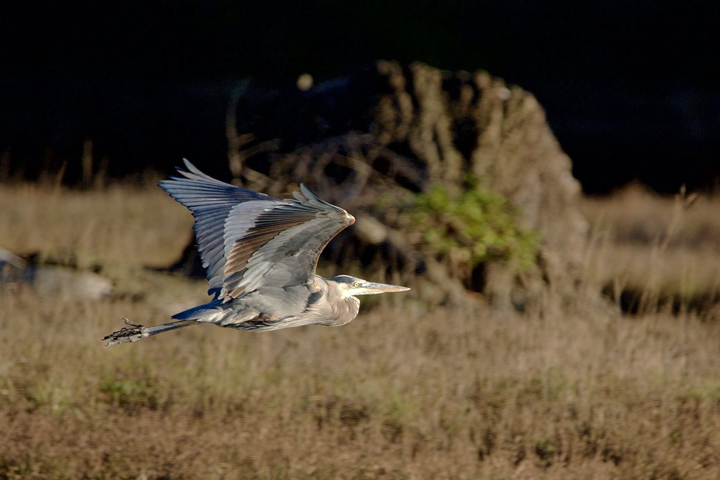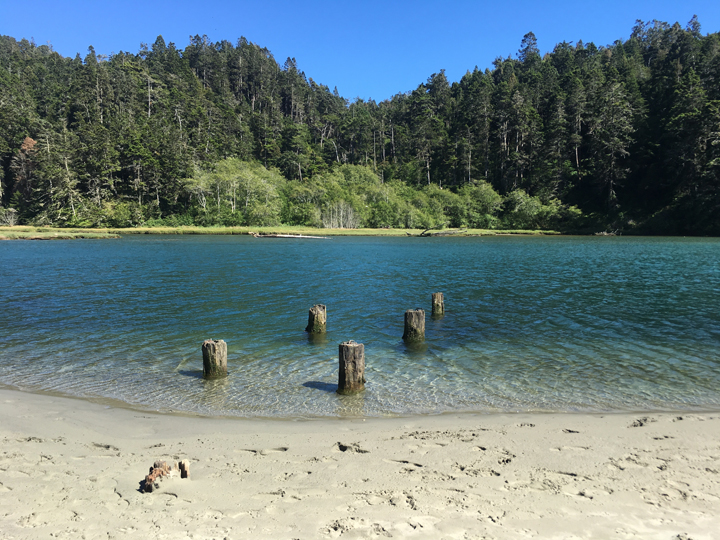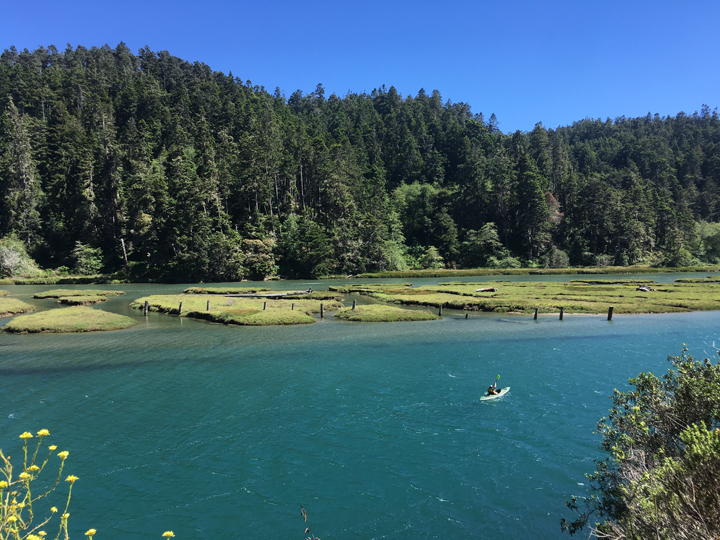 Great blue heron at Big River Estuary SMCA. photo © Sam, CC BY-NC 2.0
Great blue heron at Big River Estuary SMCA. photo © Sam, CC BY-NC 2.0
Ocean tides influence the lower four miles of Big River, including the SMCA. Saltwater can extend as far as eight miles upstream in the summer when river flow is low, and about three miles upstream in the winter when river flow is at its greatest. The brackish estuary environment supports numerous plants, birds, fish, and other animals.
However, since 1890 more than half of the tidal estuary has been buried in sediments that transformed it into a salt marsh. These marshy areas are saturated with saltwater during high tides and inundated with fresh water during high river flows, providing a constantly changing and dynamic environment suitable for juvenile salmon and some other fish, along with amphibians like frogs, newts, and salamanders.
Dungeness crabs, ghost shrimp, and other invertebrates use the estuary for food, shelter, and nursery grounds. More than 20 species of fish, including seven species of surfperch, and more than 100 species of birds can be spotted in Big River Estuary. Big River, Noyo River, and Ten Mile River have the highest abundance of coho and Chinook salmon and steelhead trout in Mendocino County.
River otters and harbor seals are regularly spotted by kayakers on the water. Bird surveys show that many fish-eating birds reside in or visit Big River Estuary. Kayakers have the best chance of seeing birds on the estuary, from ducks dabbling in the water to osprey diving for fish to the great blue herons that raise their young in the trees lining the estuary.
 Pilings from the old mill site at Big River Estuary SMCA. photo © L. Kashiwada
Pilings from the old mill site at Big River Estuary SMCA. photo © L. Kashiwada
For centuries, Native American Tribes in California have relied on marine and coastal resources. Many Native American Tribes in California continue to regularly harvest marine resources within their ancestral territories and maintain relationships with the coast for ongoing customary uses. Big River Estuary SMCA is located within the territory of Northern Coast Pomo people known as Búl-dám Pó-ma. Through a factual record of historical take within the Big River Estuary SMCA, several tribes are exempt from the MPA regulations.
The history of early settlement in the area is poorly documented prior to the start of the timber industry in the 1850s. The first steam-powered lumber mill on the Mendocino coast was built on the bluffs overlooking the mouth of Big River in 1852. After the operation at the original mill was phased out, and the second mill was destroyed by fire in 1863, a new mill was built in 1864 and operated until it closed permanently at the end of 1938. The only visible remains of this activity are old wooden pilings on the north side of the estuary.
Big River was dammed in numerous locations to create higher water flows to transport logs downstream to mills. When rains filled the dams, the dams were opened to create sufficient water to float the logs downstream. Often a year’s worth of logging effort was moved down to the estuary in one “swamping”. Logging activity, including harvest, transport, and milling, impacted the natural environment in and near Big River Estuary, damaging the riverbeds essential for salmon spawning. In the late 1990s local activists organized a national campaign to preserve local forests resulting in the purchase and transfer of more than 7,300 acres to State Parks in 2002. This includes land adjacent to what is now Big River SMCA, which was established in 2012.
 Kayaker on Big River. photo © L. Kashiwada
Kayaker on Big River. photo © L. Kashiwada
Some of the most popular activities within Big River Estuary SMCA are kayaking, stand-up paddle boarding, canoeing, and swimming. If you are planning to travel on the river, it is important to pay attention to the tides. It is recommended to go upstream with the incoming tide and return with the outgoing tide. The offshore breeze often picks up in the afternoon, which can create challenging conditions for the return journey.
In this MPA, surfperch may be taken by hook-and-line from shore, Dungeness crab may be taken by hoop net or hand, and waterfowl may be taken in accordance with current waterfowl regulations. Take of other species of fish and invertebrates can only occur west of Highway 1 or inland beyond the eastern boundary of the SMCA.
Near the northwest border of Big River Estuary there is a wide beach, well-suited for gatherings, picnics, beach games, wading, and swimming. Dogs are allowed on this beach, but must always be leashed. Park near Big River Beach for access to Big River Trail, a multi-use trail that runs eastward for miles on the high bank above the river. Exploring this trail from Big River Bridge (Highway 1) heading east for a little more than one mile will offer visitors a chance to view Big River SMCA from shore. Visitors can continue along this trail far beyond the MPA boundary and explore the Big River Unit of Mendocino Coast Headlands State Park.